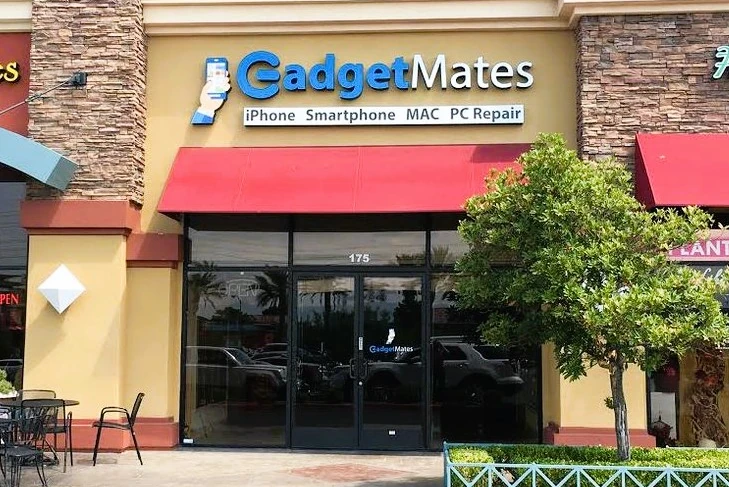iPhone Repair In Las Vegas
GadgetMates is the top rated iPhone repair shop in Las Vegas! Our team consists of highly experienced experts in iPhone screen repair, battery replacements, data recovery and more. With thousands of successful repairs completed each year, we are the leading service provider for quick, affordable, and high-quality cell phone repairs.
We do all work locally and most issues are solved same-day at any of our shops in Henderson or Las Vegas. If you are experiencing issues with your iPhone such as battery problems, a cracked screen, broken back glass, or water damage, give us a call first and we’ll run through all your options: (702) 444-0000.
We’ll Fix Your iPhone
Whatever your iPhone model, we offer the best local same-day phone repair service at the lowest prices in Southern Nevada. Our technicians are rated the highest in Las Vegas and Henderson and are trained on every iPhone model from the Original to the iPhone 16. Contact us for a no-obligation quote and price estimate. Our shop has a 5-star rating on Google and Yelp and most repairs can be done on the same day. We have been recognized by numerous organizations as a top rated service including Best Of Las Vegas, Yelp, Angi, and Google Reviews. Be sure to check us out online before you come in and give us a call if you have any questions.
Contact Information
Phone: 702-444-0000
Email: info@gadgetmates.com
Services Offered

iPhone Repair Shops
GadgetMates – Silverado Ranch
9480 S Eastern Ave #175
Las Vegas, NV 89123
Phone: 702-444-0000
Directions
GadgetMates – Sunset Park
3095 E Patrick Ln Suite 3
Las Vegas, NV 89120
Phone: 702-444-0000
Directions
How It Works
Bring In Device
Stop by a store location
Free Diagnostic
We’ll test your device for FREE & provide a quote
You Decide
You can choose to repair or not. No obligation.
Services We Offer
We Fix These iPhone Versions
Professional iPhone Repair in Las Vegas
Free Diagnostic
All of our iPhone repairs start with a Free Diagnostic. There’s no obligation to continue if you don’t wish to. Our diagnostic is performed by technicians with an aim to get you the information you need to decide if you want to repair your phone or not.
Fast and Reliable
From our multiple locations in Southern Nevada – you’ll find one near you. If you had an accident with your iPhone or it’s just not working right, come to the best iPhone fixers in Las Vegas & Henderson. We repair 1000’s of phones each year and our mission is to fix your phone at the lowest price possible. Most iPhones are repaired in just a few hours.
Transparent Pricing
Our pricing is honest, fair, and up-front. After your diagnostic you get a quote that covers all the problems that have been observed with your phone. If anything pops up once the phone is disassembled or if you want anything else done with the phone – we will always get your approval before making changes to the invoice. At GadgetMates you decide what you want done – every time.
Expertise
Our company has been in business for over 7 years in the Las Vegas area. If your iPhone is giving you trouble, we’re here to help. Whether it’s a cracked screen, accidental water damage, battery issue, or software problem, GadgetMates is the place to go. We treat our customers like family and take pride in being the most reliable and respected local iPhone repair shop. When you bring your phone to us, we will handle it with care and provide top-level service to fix your device exactly the way you want it. We are committed to using only high-quality parts to ensure lasting repairs. Whether you’re a local or a tourist, we’re here to assist you. Our staff includes CompTIA A+, Network+, and Micro Soldering certified master technicians who can handle any electronics problems. As one of the only shops in town that can do back glass repairs and micro-soldering, we take on even the most complex phone repairs that other shops refer to us. Our customers have given us 5-star ratings all over the internet. We invite you to read our Yelp, Google, and Facebook reviews to learn more about our company and how we take care of people.
Multiple Locations for Your Convenience
Stop by any of our locations across Las Vegas and Henderson to get the top rated service you deserve. We’re proud to offer unmatched expertise, fast service, and unbeatable prices. Trust the leading name in iPhone and tech repair so your device gets the best service.
- South Eastern: Located at 9480 S Eastern Ave #175, Las Vegas, NV 89123. This location is perfect for those staying on the southern side of the Strip. A short drive, and you’ll be greeted by our expert technicians ready to assist you.
- Patrick Lane: Conveniently situated at 3095 E Patrick Ln Suite 3, Las Vegas, NV 89120. It’s a prime location for visitors staying near the airport or east of the Strip.
Customer Reviews
⭐⭐⭐⭐⭐
Been a regular here because I always break my phones. You cant go wrong with this place. Jonas the manager is so focused on customer service. Jose was the technician he was great. But I came in with my 3rd broken phone in a couple months and I came out with an excellent condition Iphone12pro for an amazing deal AND Jonas helped with all the issues transferring to an esim and stayed the whole time on the phone with my carrier.
Customer service like this is few and far between and these guys will always take care of you. 4.9 stars on Google is no joke
Mike M
Las Vegas, NV
⭐⭐⭐⭐⭐
The screen of my daughter’s phone was smashed so I found a great review on nextdoor app for this place and decided to give a chance. Jonas was friendly and very knowledgeable. Not only he assured us that they can fix the phone, he also promised it can be done within 2 hours. They delivered on both promises and my daughter is very happy with the phone. The store is a little gem that you can walk in and browse and ask questions and staff is friendly, knowledgeable and informative. They also have many used PC, Laptop, tablet and other related items. The mini arcades at the entrance was a nice touch.
JC Yeh
Las Vegas, NV
FAQ
do you have a question?
You’ll see some of our most popular Q&A questions on this page. Don’t see your question answered? No problem!
Call our team or contact us and we’ll have a support specialist reach out to you.

